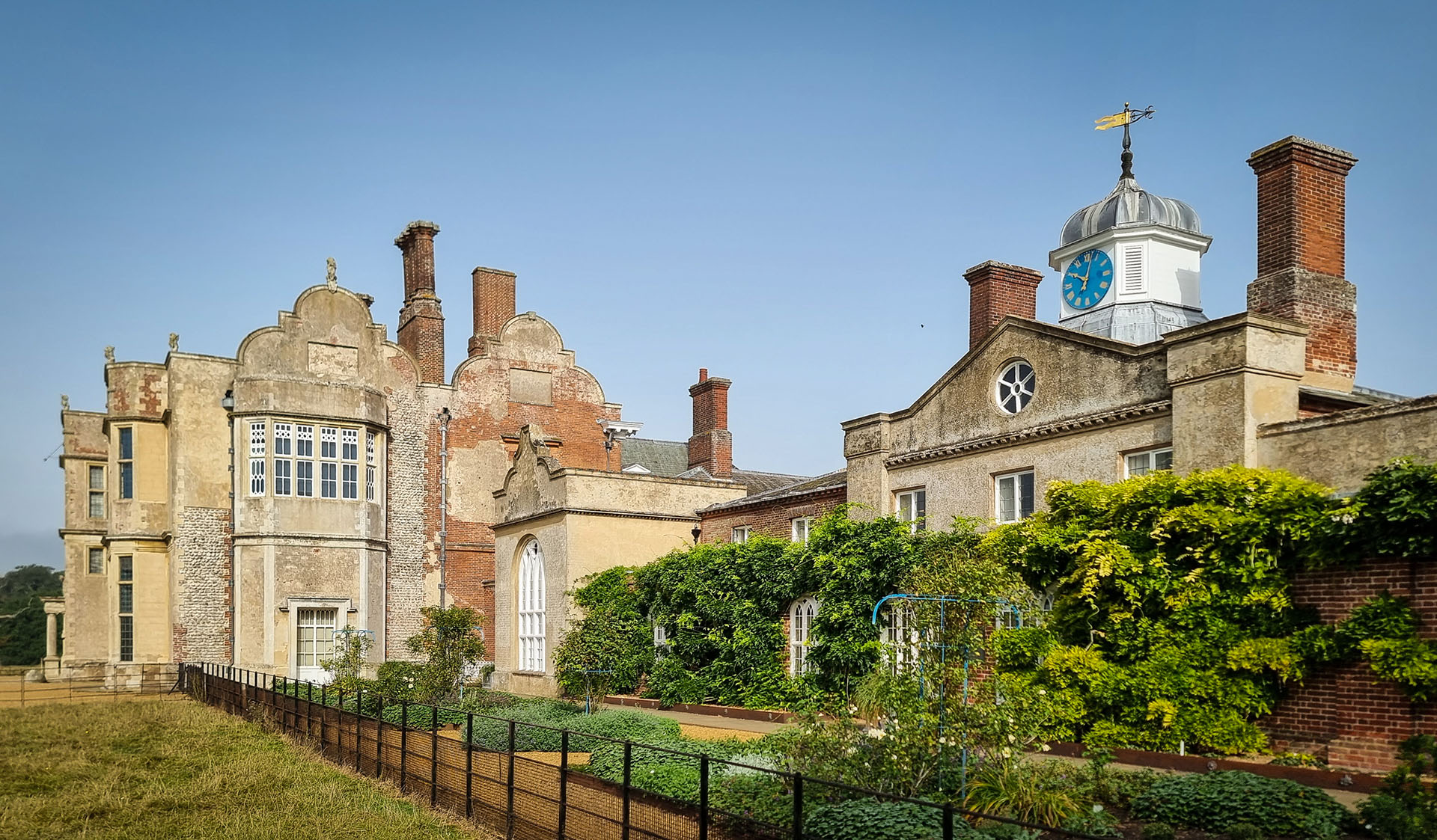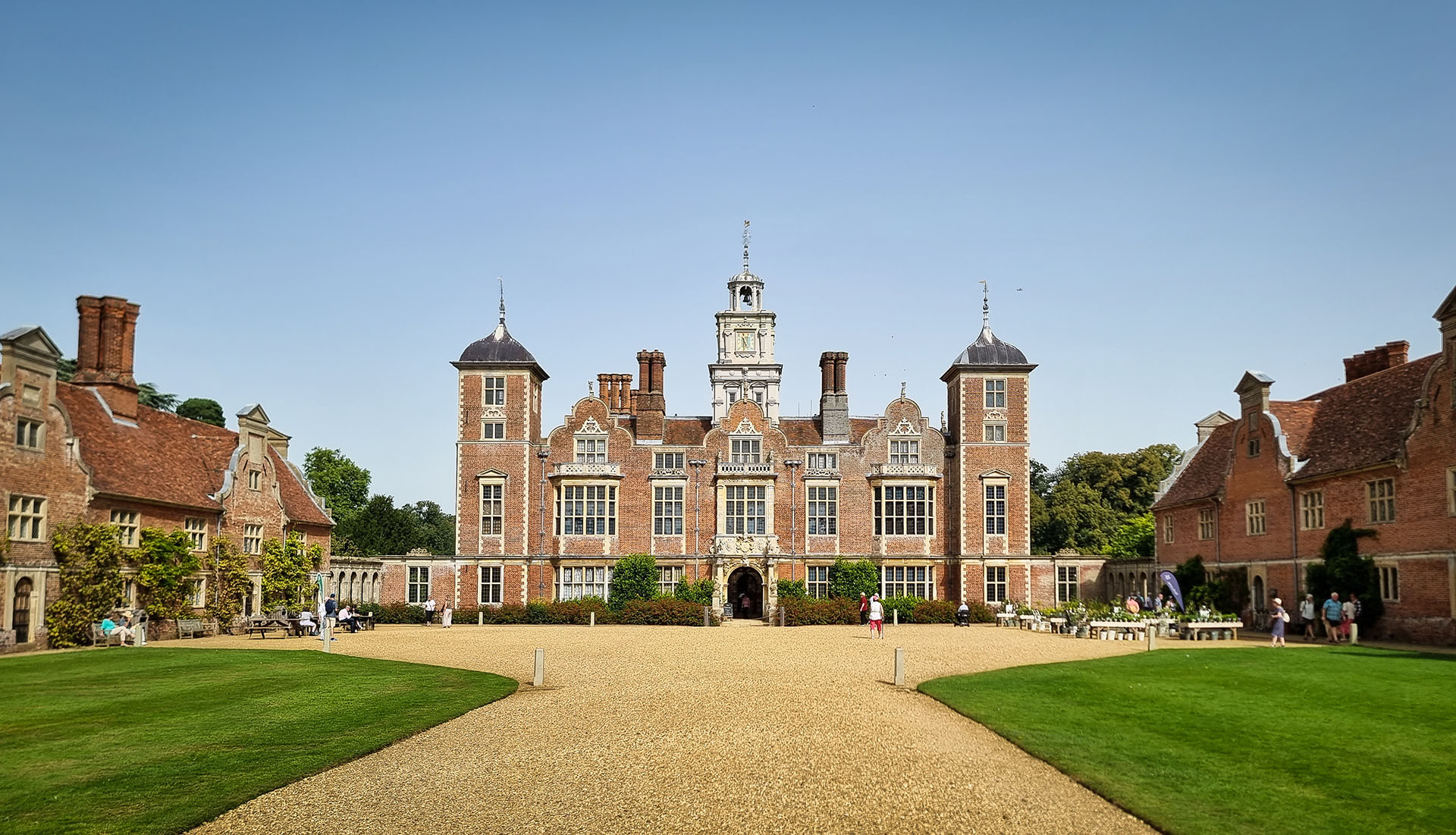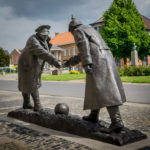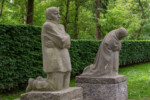Completing the Rebellion Way ride …
In Part A of this Blog, I wrote about the first three days of our Rebellion Way bike-packing ride. Here, I pick up the story from Little Walsingham (just north of Fakenham on the map below), and describe what we found on days 4 to 6. The route took us via Sheringham on the north coast, then south through Aylsham to the Norfolk Broads, back into Norwich, then south again to Diss, and back to our starting point at Walsham-le-Willows.

Full route for Cycling UK’s Rebellion Way
Day 4: Of pilgrimage, Tudor exuberance, and a spectacular fall from grace; Walsingham to Sheringham
The origins of Little Walsingham’s privileged religious status were shared by our Catholic hosts over breakfast. The story goes way back to the 11th Century, and one Richeldis de Faverches. This devout Saxon woman from a noble family was married to the Lord of Walsingham Parva, and …

The Slipper Chapel a few kilometres to the south-west of Little Walsingham
Thus informed, we set off to find the pilgrimage site, the ‘Slipper Chapel’, a short distance from the village. With no church affiliation or particular religious beliefs, I could observe the pilgrims, their rituals, and icons with no pressure, no guilt, or other complications. It seemed a very peaceful place that would encourage meditation, and that was quite appealing.
Shortly after, we passed the very fine East Barsham Manor, a so-called Elizabethan ‘prodigy’ house on account of the rich decorative style that the rich owner would have used to show his wealth and status. It was built in the 1520s by Sir Henry Fermor, and among its frequent visitors were Henry VIII, Catherine of Aragon, and Anne Boleyn (see also Blickling Hall, Day 5). Eventually, the fortunes of the hall’s owners declined, and seeing the fabulous decorative brickwork now, it’s hard to believe the house had become a ‘romantic ruin’ in the 19th Century. Fortunately, the inter-war years saw it restored to its former glory by Sir John Guinness.

The manor house at East Barsham, a remarkably well-preserved example of a Tudor ‘Prodigy House’

Cley Smokehouse café and eatery, Glandford
At Manor Barns, Glandford, we happened across the Cley Smokehouse café and eatery (note that if you find links to the Art Café, this has closed). Here we stopped for much needed refreshments and a look around the excellent and varied nature-themed art gallery. Nearby Glandford Ford looked to be an exciting prospect to ride through … except that the river bed was very loose, so I gave that one a miss, too. I was not doing well with my fords.
Holt was next – a delightful place to spend an hour or so wandering around and enjoying (another) café stop if time permits. The town is famed for its Georgian elegance, but this is largely the product of the devastating ‘Great Fire’ of May 1708 that broke out in market stalls and destroyed most of the town, including the church. It is thought that, if it were not for this fire, Holt may still resemble Lavenham in Suffolk, the latter described as ‘England’s best preserved mediaeval town’ on account of its many original timber-framed buildings.

Baconsthorpe Castle near Holt, once the home of the Heydon family who built their wealth through the Mediaeval wool trade
Nearby Baconsthorpe Castle was unfortunately closed for repairs, but (at the time – September 2023) we could still get a reasonably close-up view of the ruins. Historic England’s helpful information panels at the site told us the somewhat unfortunate (depending on your levels of sympathy) tale of the rise and fall of this once great house and its super-wealthy family.
It began in the 1450s with John Heydon I, a lawyer and agent to the Duke of Suffolk, who decided to build a home fine enough to show off his growing wealth.
Then, and following the trend of the times, the Heydon family became involved in the lucrative wool trade; by the mid-16th Century, they owned an estimated 20,000 to 30,000 sheep.
The family profited greatly by processing (spinning and weaving) the wool they produced on the castle estate. But great wealth led, perhaps inevitably, to an unsustainably extravagant lifestyle and mounting debts. And to top it all the last owner, Sir John Heydon III, compounded his financial problems by picking the losing side in the Civil War (1642 – 1651). He ended up selling off all of the family’s Norfolk estates, and was even reduced to dismantling Baconsthorpe Castle to raise money by selling the most ornate pieces of masonry.

The ‘Mammoth’ mural by David Barber on Sheringham’s seafront
Continuing north, we reached our day’s destination at Sheringham, where we stayed with friends. A pre-dinner walk took us past David Barber’s seafront Mammoth mural that celebrates local neolithic discoveries. This painting was inspired by the discovery of an almost complete steppe Mammoth skeleton on the beach at West Runton, a few kilometres to the east of Sheringham.
As we wandered past admiring the impressive artwork that took us back into a far distant past, the great creatures and ancient tropical forests were lit by the warm glow of a glorious sunset.

Sheringham sunset
Day 5: Great halls, tiny trains, and the enticing Broads; Sheringham to Norwich
This was our longest day, and at 87 km, you might think … that’s not a long day! But it all depends on how much there is to see, and on this day (though frankly, any day on this ride), there was just so much to admire and enjoy. It was quite a hilly route too and, as we have learnt, Norfolk is not flat.
The first challenge was just outside Sheringham; a very steep, off-road climb took us through woods to Beeston Regis, with remains of a Roman camp and fine views of the coastline. Entertaining tracks led through the forest and back to the road. Here, we turned steeply down a very pretty wooded lane called the Lion’s Mouth, and then rode through the park of Felbrigg Hall. This was the first of two really impressive National Trust properties that we only had time to admire from the outside.

Looking back up the Lion’s Mouth road, just before entering Felbrigg Hall Park
Felbrigg Hall is a beautiful Jacobean house built on the remains of a Tudor mansion, which itself originated on a Norman estate. So much history! From the original Felbrigg family, it came to the Windham’s, with whom it stayed for several hundred years, albeit changing hands from the Norfolk (Windham) to the Somerset (Wyndham) branch when the former ‘died out’ with no direct heirs.

Felbrigg Hall, a stunning 17th Century Jacobean mansion with a fascinating history
Among the notable incumbents were William Wyndham II and his son William Wyndham III. The older William set off in 1738, as you did in those days if you were wealthy enough, for his European ‘Grand Tour’. He spent time in Rome, returning in 1742 with an impressive collection of trophies (see note on the Grand Tour Cabinet, below). The younger William became an MP and served as Secretary of War and the Colonies from 1806. Whatever he learnt from these colonial connections and responsibilities, he nevertheless has the distinction of being one of only 16 MPs who voted against the 1807 Slavery Abolition Bill. This is the kind of heritage that the National Trust, rightly in my opinion, is now making efforts to address more openly.

With no heir, the last owner of Felbrigg Hall, Robert Wyndham Ketton-Cremer, bequeathed the house to the National Trust
Later owners set a very different example, however. For example, William Howe Windham was a Liberal MP and became a model improving landlord, taking inspiration from the Coke family at Holkham Hall and investing heavily in local farming. In 1863, with mounting debts, the house was sold to rich Norwich merchant John Ketton, but it fell into decay in the early 20th Century before being passed to a nephew, Wyndham Cremer.
His son, Robert Wyndham Ketton-Cremer (‘The Squire’) took great interest in, and care of, the house. Being gay and without children of his own, his story was marked by tragedy in 1940 when his younger brother and heir was killed in WW2.
The house was bequeathed to the National trust on the Robert’s death in 1969. Felbrigg became a focus of controversy for the Trust over the management of a “Prejudice and Pride” LGBTQ+ themed event in 2017, which included a film narrated by Stephen Fry to mark 50 years since the decriminalisation of homosexuality. The Trust was criticised for what was seen by some as a public outing of Robert Ketton-Cremer (although others said that his sexual orientation was already widely known), and also for requesting that staff wear a badge featuring the charity’s logo with the colours of the LGBTQ+ pride flag (a request later dropped, making this optional). The National Trust lost a number of members following the publicity about this matter [Wikipedia]. Recent years have also seen efforts to change the way in which the Trust is being managed, most notably by the Restore Trust group, which is campaigning to counter what is sees as a policy ‘driven by modish, divisive ideologies’.
The house and estate are remarkably beautiful, and this sumptuous and largely unchanged 17th Century mansion offers a great deal to explore inside and out, including a walled garden, and the most complete ‘Grand Tour Cabinet’ in the country. Felbrigg is described on the Trust’s website as ‘both a remarkable survival of 1750s luxury, and a precious insight into the complex, often painful, global situation that made it possible’. That sums up its complex and fascinating history very well.
Next up was the Itteringham community shop and café, famed for the great coffee and sausage rolls – and they were both very good. Soon after, we reached Blickling Hall, the second National Trust property for the day and perhaps the most stunning of the whole ride.

Blickling Hall, a great Tudor house thought to have been the birthplace of Anne Boleyn
Like Felbrigg, Blickling is a Jacobean mansion built on the ruins of an earlier Tudor house. Its first owner was Sir John Falstolf of Caister (1378 to 1459), a knight who ‘made his fortune’ from the Hundred Years War. I wondered how one does that … and it seems that Henry V rewarded his efforts through gifting multiple estates in Normandy which provided a regular income. Falstolf repatriated his wealth to build Blickling, among other properties. Around the middle of the 15th Century, the hall passed to the Boleyn family who had made money through the fabrics trade (mercery) in London. It is (strongly) believed that Anne Boleyn was born at Blickling in 1501, or thereabouts.
The current house was built on the site of the Boleyn mansion from 1616 by Sir Henry Hobart, MP, lawyer, and Attorney General from 1606 to 1613. He went on to hold the prestigious position of ‘Chief Justice of the Common Pleas’, which was the second highest common law court in England until 1875. It’s a house with a history of highly influential individuals, men and women.
During the Second World War, the hall served as an officer’s mess for nearby RAF Oulton, then a bomber station, now returned to farmland. Other ranks, both men and women, were housed in Nissen huts in the grounds. Among the treasures to be admired in the house is the Long Gallery, with its 12,500 books being a ‘nationally important collection’ and the largest in the care of the National Trust.
The more recent history of the house is interesting and significant in a number of ways. The last owner was Phillip Kerr (1882 – 1940), 11th Marquis of Lothian. He was a leading light in promoting the National Trust Act of 1937, which allowed large (country) houses to be bequeathed to the Nation in lieu of death duties. It’s also of interest that Blickling, as part of the Trust’s ‘Renewable Energy Investment programme, has since 2016 been running a heat pump system that warms the main house and one service wing by extracting energy from the lake water. It is said to be saving around 25,000 litres of oil each year. Impressive!
Having added Felbrigg and Blickling Halls to the ‘thorough look RVL’, and following refreshments at the pretty town of Aylsham, we hit the trail beside the Bure Valley Railway, a narrow gauge line that runs 15 km to Wroxham.

Beside the Bure Valley Railway

Norwich Cathedral
The first half was pleasant enough, and I enjoyed the trains, views, and charming little rural stations. But to be honest, 15 km of trackside trail gets to be a bit much. The line ends in Wroxham, the commercial centre of Norfolk Broads boat hire. From there, we rode east on a short foray into a section of quite hilly countryside to the south of Hoveton Great Broad, and the Woodbastwick and Bure Fens and Marshes.
You don’t get to see much of the Broads from the road, at least not on the Rebellion Way route. Most of the waterways are quite hidden away if you are not on a boat, although at the village of Ranham there was an attractive quay on teh southern edge of Ranham Broad, and a tempting waterside café.
From there, it was a bit of a haul into Norwich, fighting tiredness and some wicked virus that had been plaguing us for a few days. Heading into the city from the suburbs, we crossed Moushould Heath. This attractive green space was the scene in 1549 of what seems to have been the entirely justified but ultimately unsuccessful Kett’s rebellion against the enclosure of land by wealthy landowners. The defeated rebel leader, Robert Kett, was tried for treason and hung from the walls of Norwich Castle.
Descending to the centre of the city, we rode through the pretty cathedral quarter but as it was already early evening, I added the elegant church to my ever lengthening ‘RVL’, and sought out our pub B&B in the south of the city.
Day 6: Rebellious Iceni, quiet bridleways, and evocative ruins; Norwich to Walsham-le-Willows.
Last day! Having started between Diss and Thetford, we had left the Iceni-themed section that Cycling UK has drawn on to give this route its ‘rebellious’ identity until today.
The first major site just out of Norwich was Venta Icenorum, once a thriving Roman town created as the capital of the Iceni Tribe in around AD 60 and occupied throughout the Roman period. The area is enclosed by substantial ramparts. Excavations have found evidence of the usual range of buildings constructed by the Romans, including a forum, temples, baths, homes and possibly an amphitheatre. There are some useful information panels with illustrations around the site.

The cunning viewing window at Venta Icenorum that projects original buildings onto the landscape

On a bridleway, Wacton Common
Quiet lanes through more pretty villages led us to some of the best gravel and grass bridleways of the whole trip, with Wacton Common the highlight.
This area is thick with churches reflecting the former wool wealth, including some long abandoned. That at Tivetsall St Mary, set in a small woodland beside the lane and surrounded by an overgrown cemetery, served as a sad reminder of depopulation, and the trade that was once the commercial life blood of Norfolk, and much of England.
Passing Frenze Hall, we splashed, with last-day abandon, through a ford near a junction with Boudica’s Way, then rolled into Diss for a relaxed lunch on the terrace of a pub by the town’s charming lake. From there, it was just 25 km on more quiet lanes back to Walsham-le-Willows.

The ruined church of Tivetshall St Mary
Reflections on the route and suggestions for an ideal itinerary for the Rebellion Way

The ford near Frenze Hall, en route to Diss
Riding the Rebellion Way was a great trip, for sure, with a total of 417 km for us over 6 days/5 nights and 2,546 metres (8,353 feet) climbed. So, the route is not particularly hilly, but neither it is ‘almost flat’.
Then there is that frustratingly long list of places, National Trust properties, Historic England sites, and a good deal more, that were glimpsed but not properly explored.
Cycling UK is doing a great job, but my ‘RVL’ from the Rebellion Way is far too busy! Last year we completed King Alfred’s Way, perhaps the best (or at least most varied) of the recent crop of Cycling UK’s routes so far. But with that ride too, I felt those designing the route and itineraries have not actually stopped to explore all of the amazing places and history so amply described in the guidebook.
If your mission is just to get around the route quickly, as a physical challenge perhaps, that’s fine. But if, and perhaps especially for older (aka slower) cyclists and others as interested in the landscape and history as in the biking, a more realistic assessment of pace and what can be covered each day is needed.
So, if you want to enjoy all (or even most) of what the Rebellion Way has to offer, I reckon eight or nine days would be about right. If you have the time, adding two or three more days exploring the Broads by boat would be a very attractive option. We will definitely look at adding that to a future visit to Norfolk.
If one can devote a couple of weeks to this ride (and other places of interest such as the Broads), that feeling I was left with of having seen but not fully engaged with the history, landscape, and people of Norfolk, would perhaps have given way to a deeper appreciation and more vivid, enduring memories.
Author’s note on posting my Rebellion Way blog in two parts
There is just so much of interest on this ride, both in terms of what there is to discover as well as the experience of the cycling, that I have opted (as with King Alfred’s Way) to write up my blog in more than one part. That way, neither part is too long. But I’d be interested to hear whether readers feel about this approach, as opposed to posting one long article.






For me, writing this blog in two parts is the correct thing to do – we cycled the Hebridean Way in September and I wrote about it over THREE blog posts! I think we must be pretty similar to yourselves… now being retired, we now have the luxury of time to spend on these routes!
We plan to cycle the Rebellion Way over 6 days next April.
Thanks – that’s good to know.
I found this an enjoyable blog so thanks for that. I’m wrestling with doing this through a bike tour company who book the hotels (with me carrying luggage) or just winging it and booking on the fly as you mentioned earlier in your blog. It will be outside season (May June or September) and travelling solo. This would also give flexibility on visiting what I can without feeling I have to work to a schedule. And probably a little cheaper but balanced against availability and bike friendly accommodation certainty. Decisions decisions! What would you suggest if you had to do it again?
Thanks
Hi Robert, many thanks for this. If out of season, and (like you, I think) I’d be wanting to stop, explore, visit places, I’d definitely go for the book as you ride option. Do keep in touch – I’d be very interested to hear how you get on. Best, Nigel